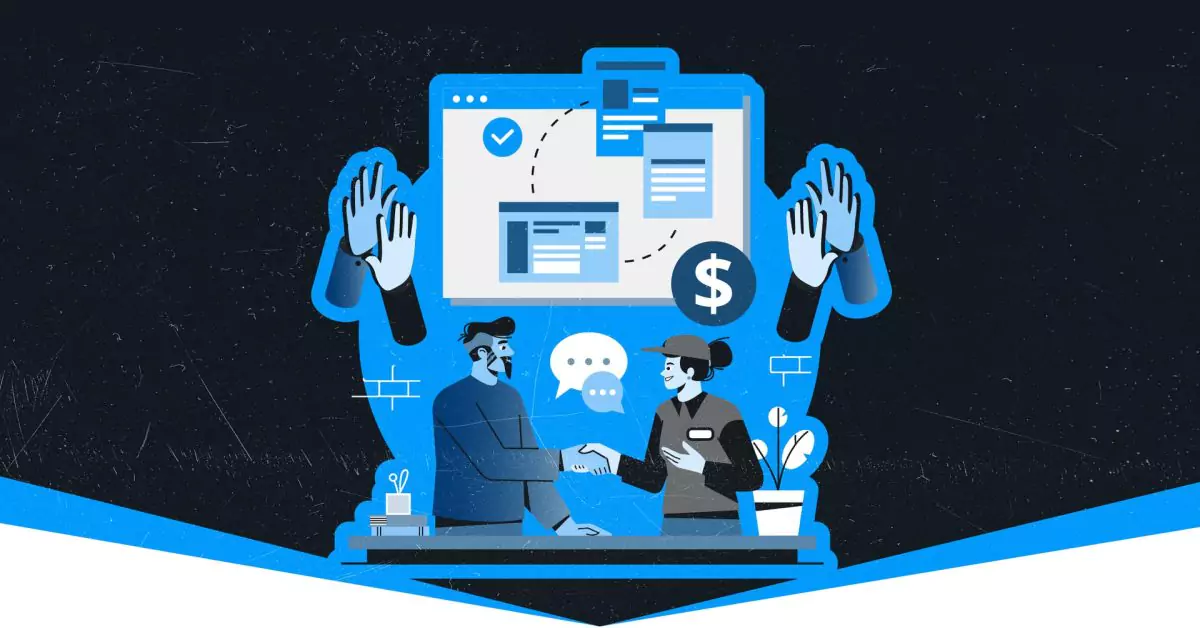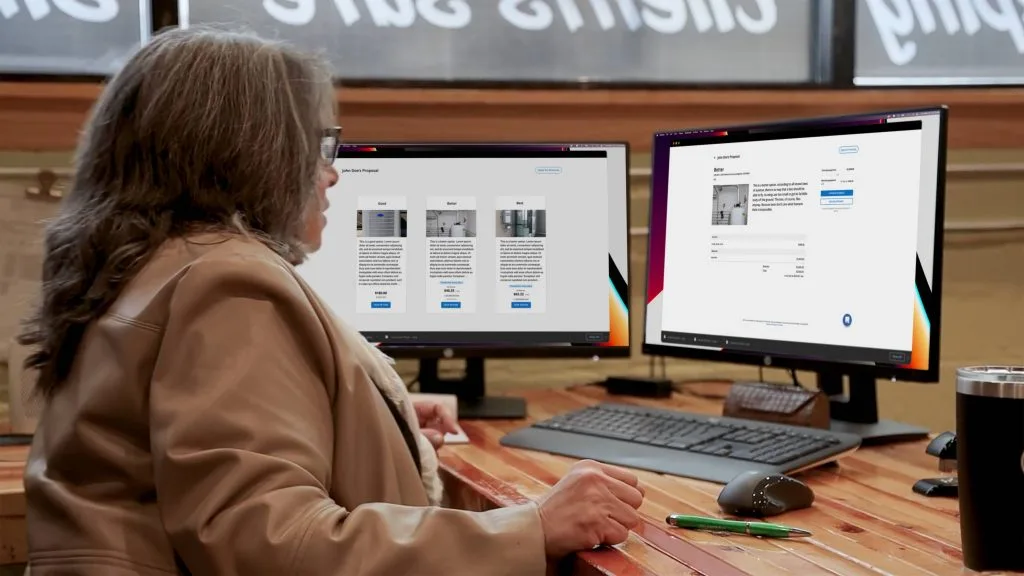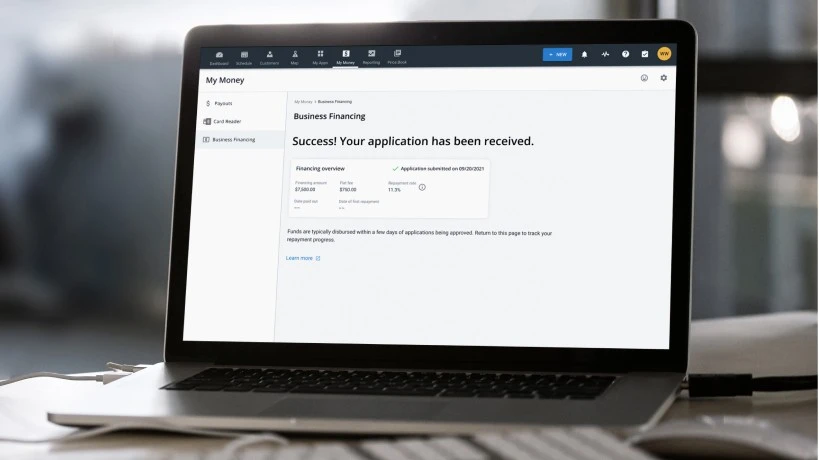
Have you ever gone to purchase something, caught a glimpse of the price, and walked away since it was out of your budget? Chances are, your customers have, too. They might’ve even done that with your services: spotted the total on the invoice, checked their budget, and put the project on the back burner.
That’s where consumer financing comes in. It offers exceptional flexibility, closing that gap for customers on a budget and boosting your overall sales.
Whether you opt for in-house financing or third-party financing, a popular form of customer financing for small businesses, choosing to integrate this option can make a world of difference for both your business and customers. Here’s what you need to know about how to offer financing to your customers.
What is Customer Financing?

Customer financing is a service businesses offer to help their customers finance the products, goods, or services they purchase from them. It’s just like other types of financing in that it gives the customer the ability to pay for a product over time.
Why Should I Offer Financing to My Customers?
Financing can be a great option to add to your business’s repertoire for a handful of reasons, the most notable being the increase in sales. Home services, whether you’re in the HVAC, plumbing, or electrical industries, aren’t cheap. For many customers, paying a few thousand dollars out of pocket is a big ask.
Times are tough, so some folks might be unable to foot the bill for your services up-front. With financing, you offer that much-needed payment flexibility. With this option, your customers can spread their payments out over time. They can still meet their budget while enlisting your services, and you still get paid.
It’s a win-win: you get to enjoy increasing sales while your customers get budget-friendly services. This can translate to more frequent requests for your services and repeat customers.
While the increased sales benefit is undoubtedly the star of the show, offering financing can benefit your business in more ways than one, including:
New Customers
Customers enjoy flexibility, especially if they don’t have a few thousand dollars hanging out when their HVAC system goes haywire. Your financing option may draw in customers who previously couldn’t afford the out-of-pocket costs all at once. Now, since you offer a flexible payment option, they might be more inclined to choose you.
Stand Out From the Competition
More and more home service companies are beginning to offer financing, but it’s not yet the norm. Offering financing can help set you apart from the competition, making you a more popular choice in your local market.
If someone can’t afford your services, they’re not going to choose you. Since your financing options don’t involve biting off more than they can chew (instead, it’s broken up into easily manageable tidbits), they’re more likely to choose you than the other guy who only offers upfront payment options.
Improved Customer Satisfaction
The flexibility of financing is attractive to many customers because it allows them to afford the services they need. No more putting off the must-do home maintenance or repairs due to a tight budget—this way, they can afford your services (at a monthly price that fits their budget).
This can boost customer satisfaction, making them more likely to remain loyal and recommend your business to friends and family (don’t forget to have a stellar referral program in place).
What Financing Options Can I Provide My Customers?
If you want to offer financing to your customers, you have two primary options: in-house financing and third-party financing. Each option has advantages, so you may find that one option better suits your needs.
In-House
With in-house financing, you’ll directly offer loans to your customers for your services or goods. You’ll need your own financing program setup, acting as both the creditor and service provider.
This usually means you’ll need some sort of system to track what cash you pull from your company’s balance sheet and details surrounding the invoice, including the date you provided the services, the amount of the monthly payment, and the timeframe of the loan.
In-house financing is an excellent option for businesses that want to set their own credit terms and approval criteria. However, it’s important to note that you’ll be assuming the risk of lending to the customer, so if anything goes sideways, you’ll be responsible for following up on missed payments.
Additionally, since you’ll be funding your own loans and pulling those funds from your business’s balance sheet, you’ll have some limitations. Those funds will be tied up in the payment plans, which can limit the amount available to invest in marketing, growth, or similar initiatives.
Third-Party
With third-party financing, you get the best of both worlds, making it an excellent form of customer financing for small businesses. It allows you to provide your customers with flexible payment options without having to assume the risk of lending. Plus, you won’t have to worry about managing the loan yourself, which can save time on administrative headaches.
The third-party provider will take care of the specifics of the process, including conducting credit checks and collecting payments. Generally, you’ll receive the full payment as soon as you finish the job. After that, the payments are between the lender and your customer.
If your customer misses a payment or goes radio silent, the lender is responsible for tracking them down to see what happened. Because of this relationship, your choice to integrate third-party financing won’t impact cash flow.
Of course, you’ll generally have to pay for the convenience of this option. Fees vary based on the provider but are often fixed. For example, let’s say you choose a provider that charges 3% for each transaction. Your customer chooses to finance their $500 service invoice, and 3% of that ($15) goes to the third-party provider.
How Does Consumer Financing Work?

The workings of consumer financing look a bit different based on which route you go, but the basics remain the same. Before we get into how to offer financing to your customers, here’s an overview of how consumer financing works:
1. Approval
Before starting the job, you’ll need to wait for the green light that lets you know the customer has been approved. If you offer in-house financing, you’ll be responsible for determining who is eligible.
However, if you go with a third-party provider, wait until the lender approves or denies the application.
It’s important that you don’t start the job before you have all of your financing ducks in a row. If you buy pricey materials or complete the job before getting the green light and the financing falls through, you might take a significant loss or be left with supplies that are hard to resell.
2. Complete the Job
After you work out the financing details, it’s time to complete your side of the agreement by completing the job. At this point, the client should have been accepted for the financing program and agreed to the applicable conditions and payment terms.
Complete the job as you normally would for a customer paying up-front.
3. Receive Payment
Once all is said and done, you’ll receive payment. If you go the in-house route, you’ll receive payment based on the agreed-upon terms and payment plan.
Or, if you go with a third-party lender, you’ll receive the full payment from the lender as soon as the job is complete. After that, the customer will make payments to the lender over the agreed-upon time frame until they pay in full.
How to Offer Financing to Customers
With the basics in mind, your next question probably centers around how to offer financing to your customers. Offering financing can feel like a big step (and it is), but it doesn’t have to be too complicated. Here’s the basics of how to offer financing to your customers:
Choose a Lender (or Not)
First things first, you need to set up your financing program. If you go through a lender, make sure you choose one that meets your specific needs and requirements. Most lenders have specific requirements, such as minimum loan amounts, so it’s important to choose carefully.
Or, if you plan to go the in-house route, you’ll need to work out the details of your financing program. Determine all of the specifics, including your approval criteria, credit terms, and tracking system. Since you’ll be tracking it all yourself, make sure you have all of the specifics well and truly defined.
Advertise the Update
Once you iron out the lending details, you’ll need to let your customers and potential customers know you offer financing. If they don’t know you offer it, they won’t use it, so it’s your responsibility to let them know.
Add a page to your website dedicated to financing. Explain how it all works, detailing the steps involved, what they can expect, and how to apply. Make it easy for visitors to find the financing page—don’t make them hunt for it.
Additionally, integrate a blurb about it on quotes and estimates. It doesn’t have to be super detailed since you should go into all of the specifics on your website. Instead, give them a quick overview of what you offer and where they can find more information about it.
Accept Applications
Once your customers know about your financing option, they can apply as needed. With the in-house route, they’ll apply as directed on your financing page. Review the applications and accept or reject them based on your internal criteria.
Or, if you go with a third-party lender, you can include a button redirecting them to apply through the lender. The lender will approve or deny the application based on their findings. Generally, this consists of a credit check (sometimes both soft and hard credit checks). Once they decide one way or the other, they’ll notify your customer whether their application has been accepted.
Offer Your Services with Financing
The last step in how to offer financing to your customers is to start working! Once your customer is approved for financing, whether in-house or by the lender, you can offer your services with the financing option. It can be a bit of an adjustment in the beginning, but once you get the hang of how things work, it becomes significantly easier (especially if you go the third-party route).
For an even easier transition, choose a provider (if you go the third-party route) that offers an integrated approach to financing. This way, you won’t have to deal with major changes that require a massive learning curve.
Get In Touch: 858-842-5746
Let us earn your trust
On average, Pros increase monthly revenue generated through Housecall Pro by 50% after their first year.
See plan options and feature breakdown on our pricing page.
Pros and Cons of Offering Customer Financing
Like most things business-related, customer financing has pros and cons. So, if you’re debating whether or not you should integrate customer financing into your home service business, it’s important to take a good look at both the benefits and drawbacks to ensure it’s right for your goals.
Offering Customer Financing: Pros
Customer financing can be wildly beneficial for your business, helping with everything from closing more jobs to setting you apart from the competition.
First, you get to give customers more flexibility. With financing, you can cater to customers with a wide range of budgets. This way, your customers can pay over time. $50 monthly payments are much more manageable than a $1,000 out-of-pocket bill.
Second, you might close more jobs. Home repairs and services aren’t cheap. When an HVAC system decides to retire early, a clog conveniently lodges deep within a home’s plumbing, or the electrical system takes a vacation, fixing things can be expensive. That initial cost can be a barrier to entry for many customers. So, by offering a payment plan, you might find that you close more jobs (thanks, financing flexibility!).
Third, there’s the matter of improving your customers’ experiences. Who doesn’t appreciate flexibility, especially in the cost department? For most folks, a bit of leeway there goes a long way. Your financing plan provides exactly that: wiggle room. So, by offering financing, your customers get a better overall experience, which reflects well on your business, can boost loyalty, and may even lead to more referrals.
Free ebook: Ultimate Guide to Streamlining Customer Experience for Home Services
And, last, but certainly not least, it can help set you apart from the competition. Financing in the home service industry isn’t the norm yet, so by implementing it now, you stay ahead of the game. This can help set you apart from the competition, establishing your services as an affordable option for people with varying budgets.
Offering Customer Financing: Cons
In-house financing, while beneficial, has a few disadvantages that are important to consider. Most notably, it adds complexity. Dealing with your own financing setup can be somewhat of a hassle, given that it adds to the overall administrative burden. You’ll be responsible for vetting customers who want to go the financing route, which takes time and effort.
It also means you’ll be assuming risk. Since you’re lending directly to your customers, you’ll assume the risk associated with lending. If your customers abruptly stop paying or miss a payment, you’ll be responsible for contacting them to sort it out.
While third-party financing is undoubtedly a popular form of customer financing for small businesses, it, too, has a few drawbacks. The minimum transaction limits are a big one. Most third-party providers have specific minimum transaction limits. This means that if a transaction doesn’t meet that lower threshold, it won’t be eligible for financing.
The service fees are another not-so-great aspect, but it is a bit of a trade-off since you’re paying for convenience. Each third-party financing provider has its own fees and expenses associated with the service. These rates vary from one provider to the next, but regardless of which they choose, they detract from the total amount you walk away with after completing a job.
Consumer Financing With Housecall Pro and Wisetack

Customer financing for small businesses, or businesses of any size, for that matter, can be a lucrative addition. It can close that barrier to entry to your services for customers with tighter budgets, boosting your business and sales without requiring your customers to shell out cash upfront. It’s a win-win for both you and your customers.
If you’re ready to integrate consumer financing into your business operations, Housecall Pro can help. Partnered with Wisetack to make consumer financing more accessible than ever, Housecall Pro can assist in streamlining your new financing addition (not to mention your entire business operations). Payment collection, scheduling, dispatching, and invoicing—all made gloriously straightforward.
Learn more about Housecall Pro’s app, designed to streamline everything from consumer financing to daily business operations. Start a free 14-day trial today.





